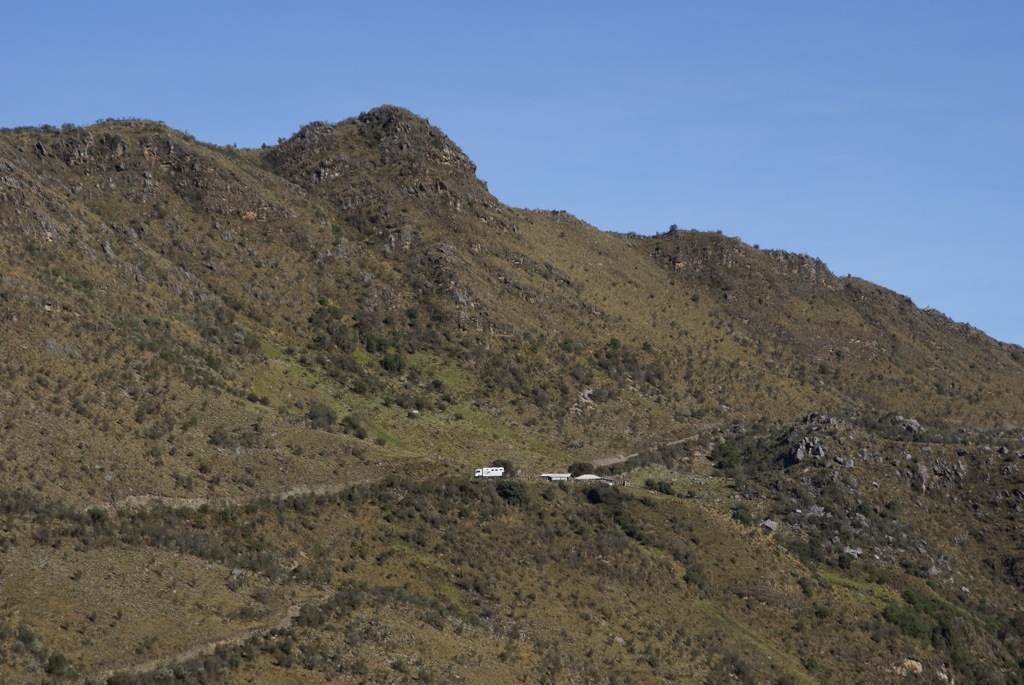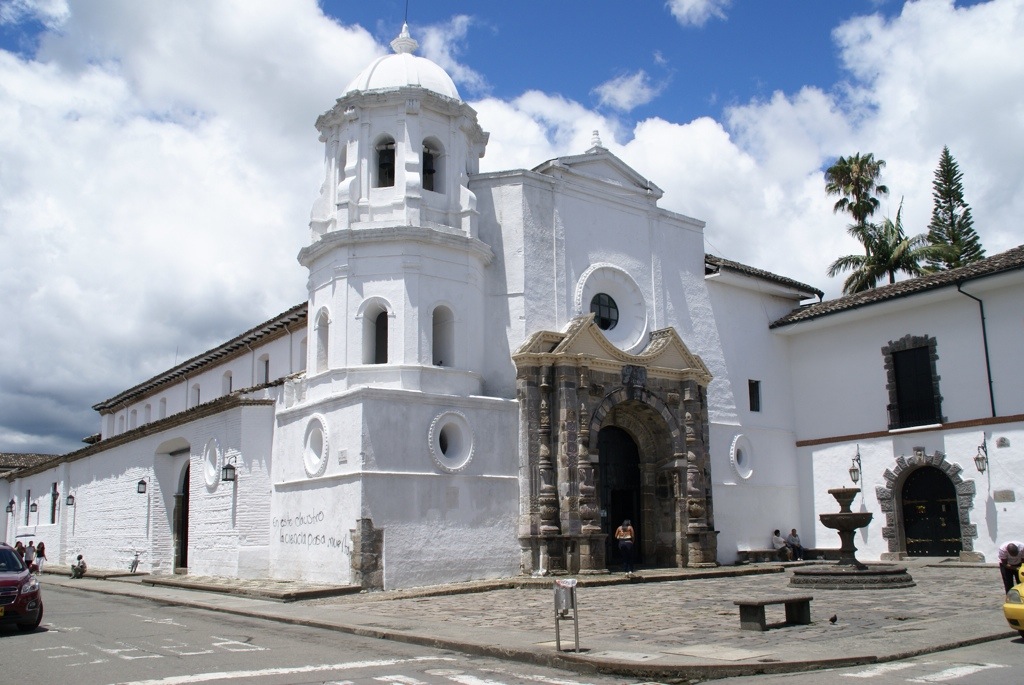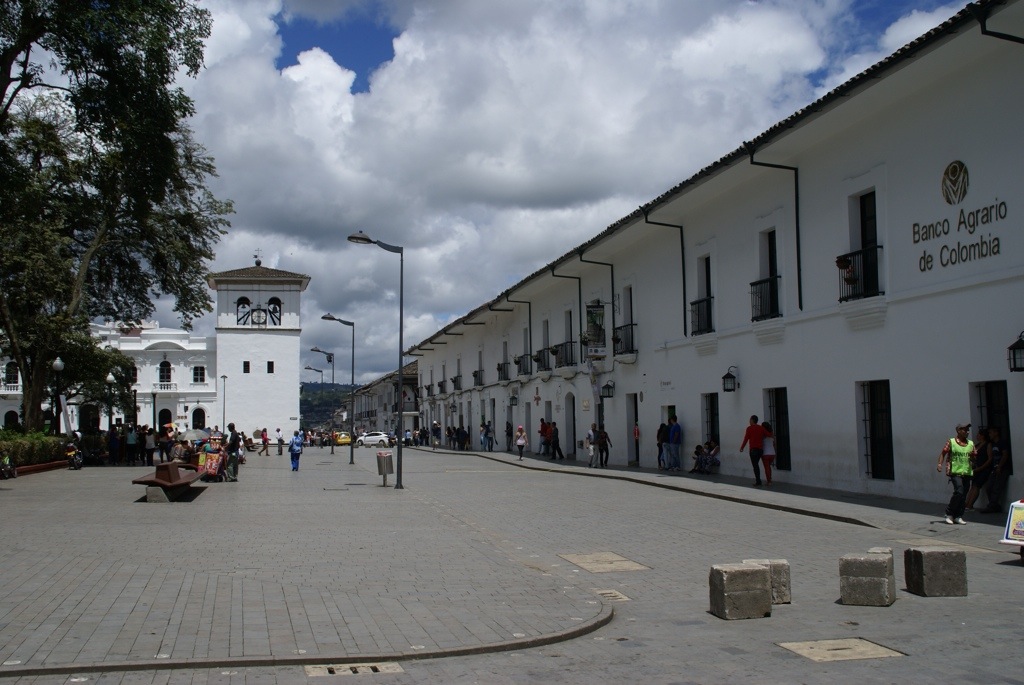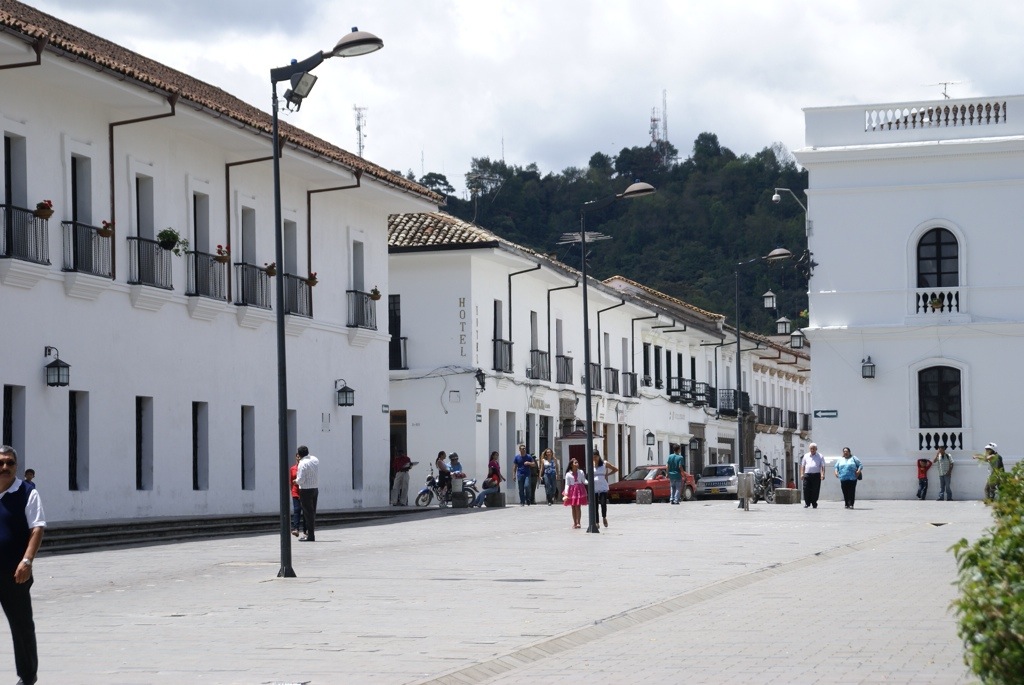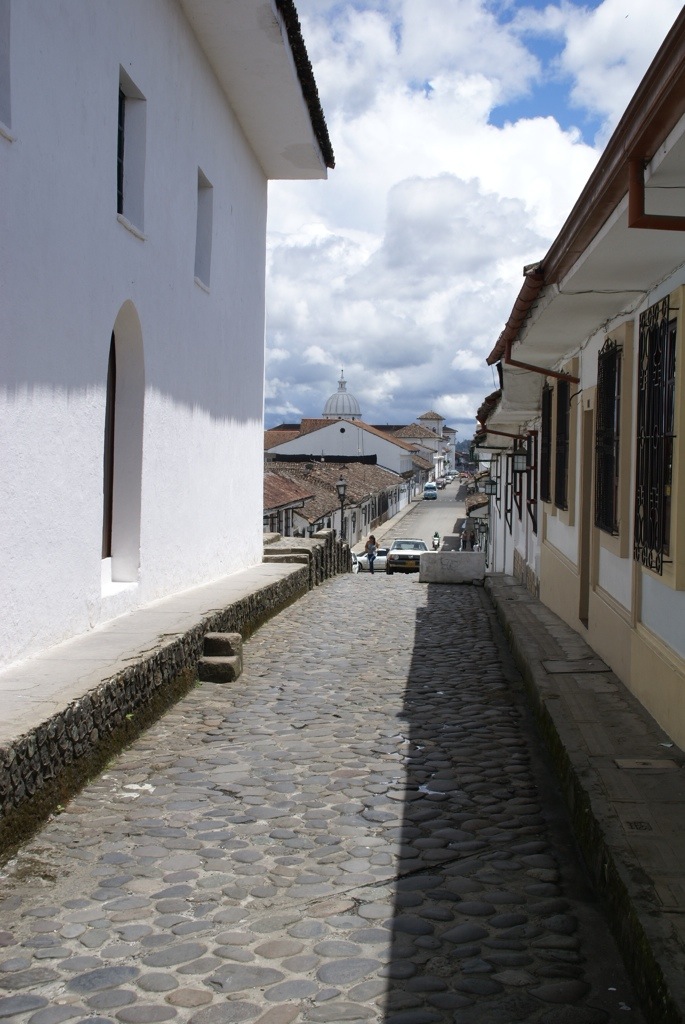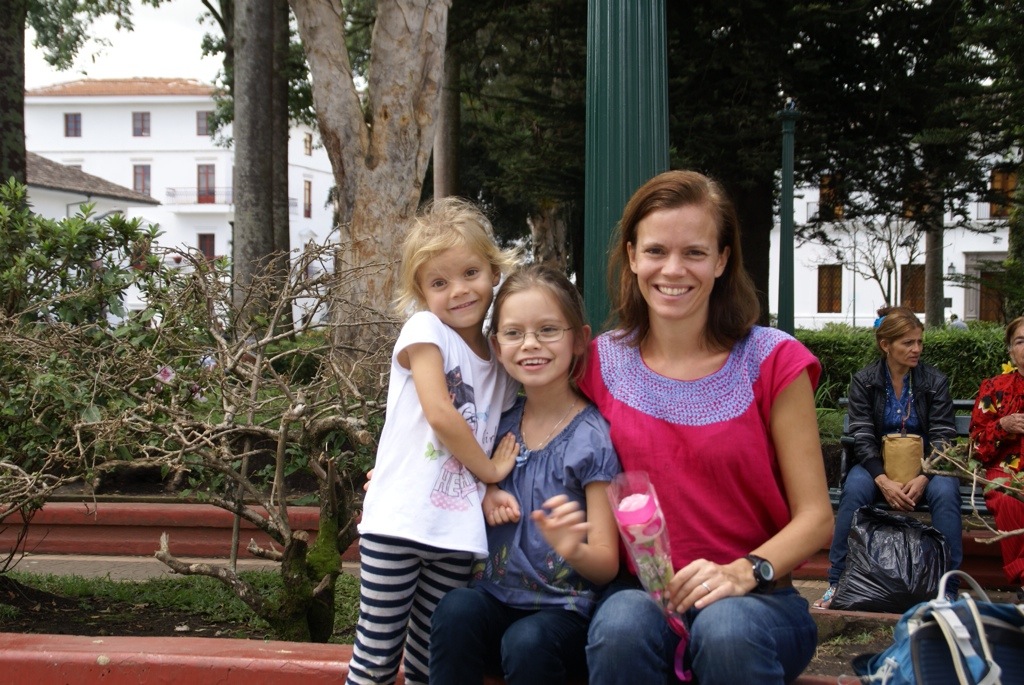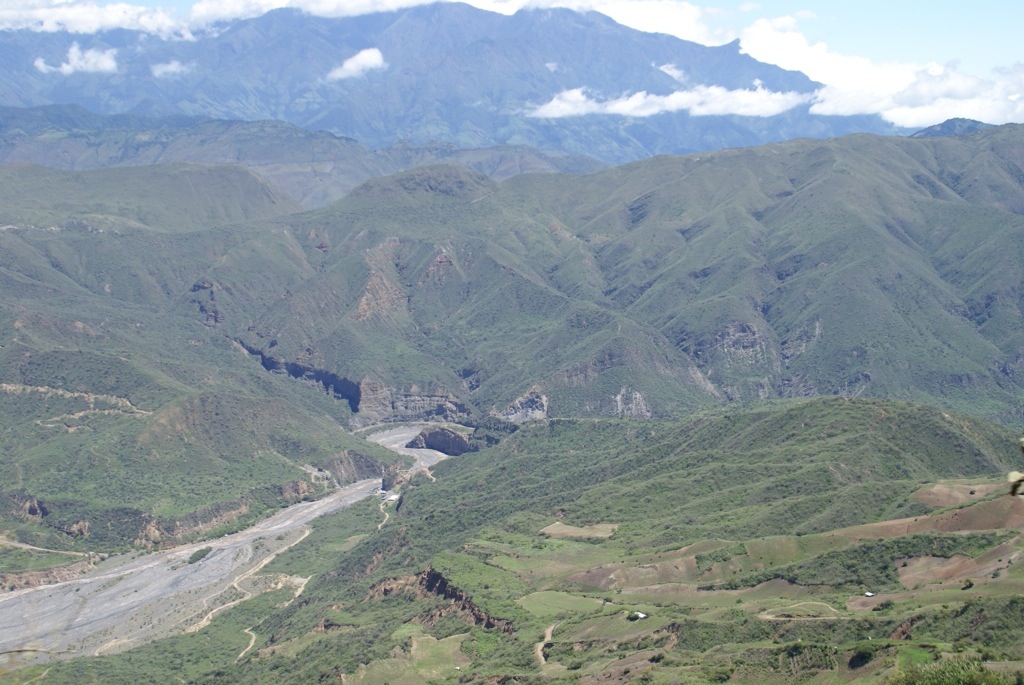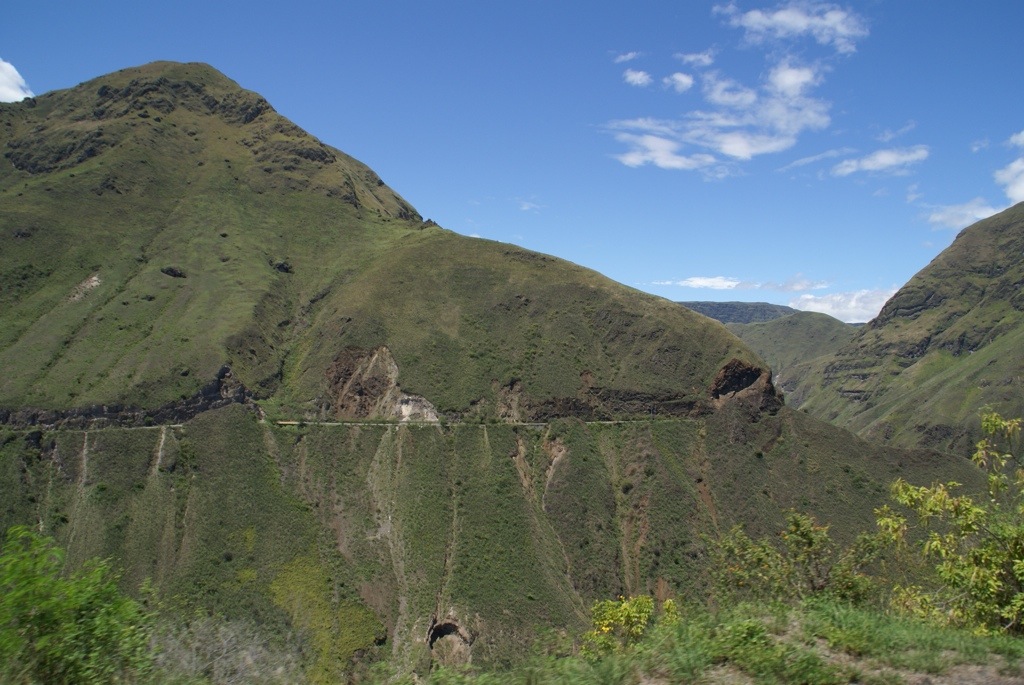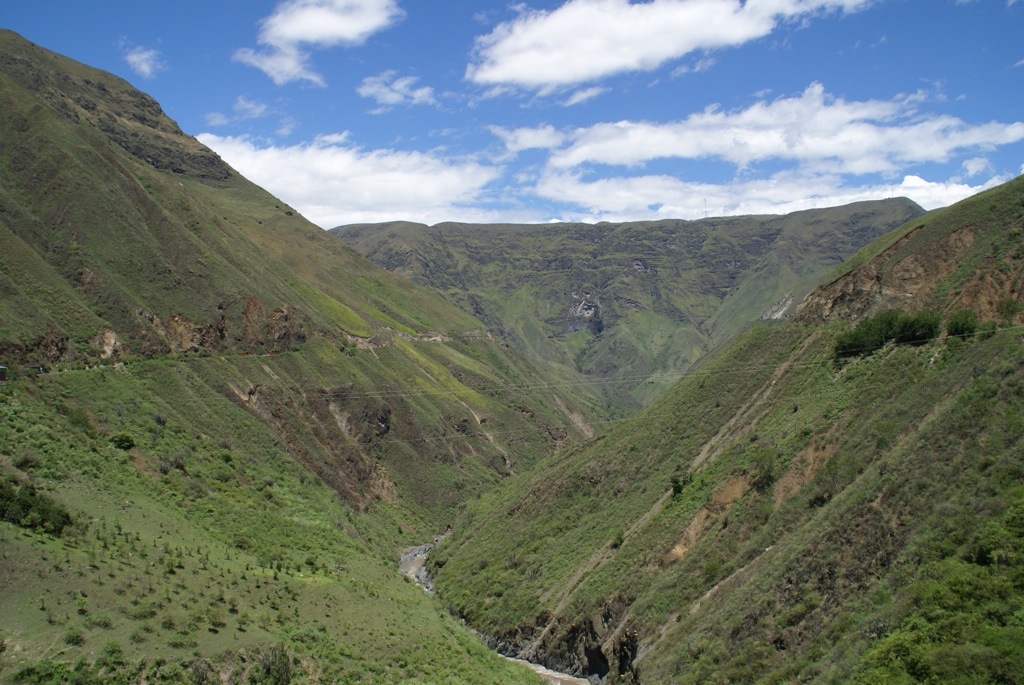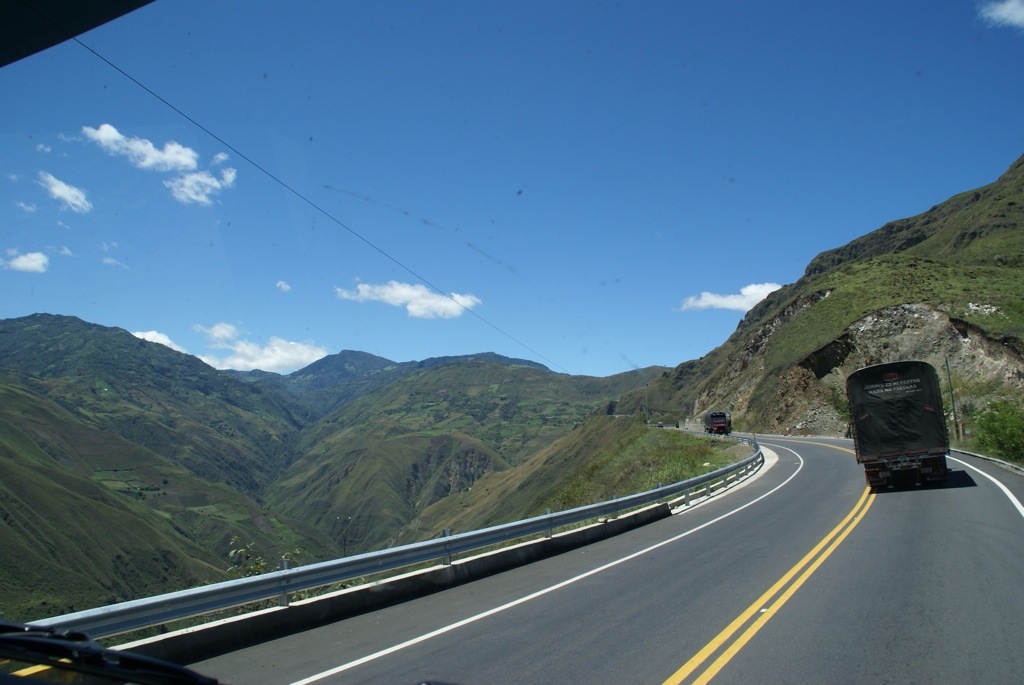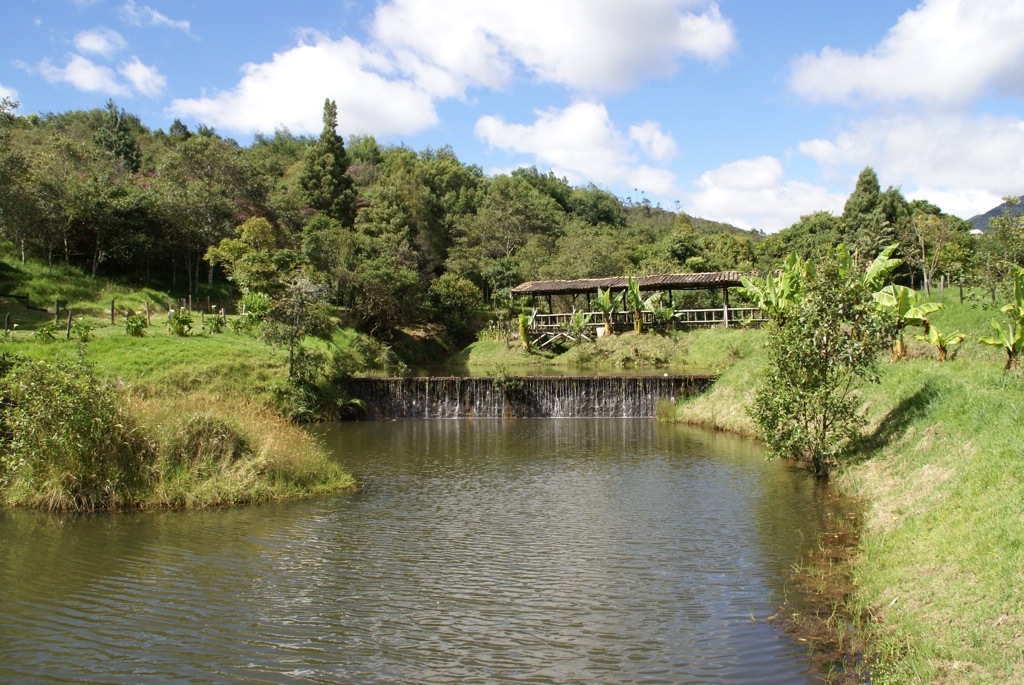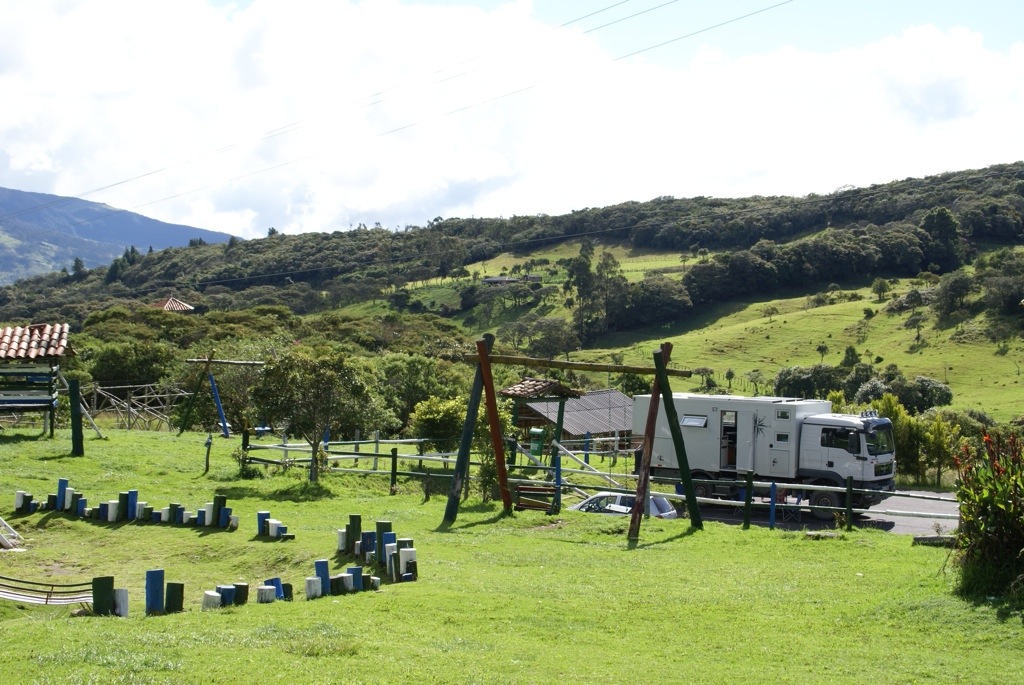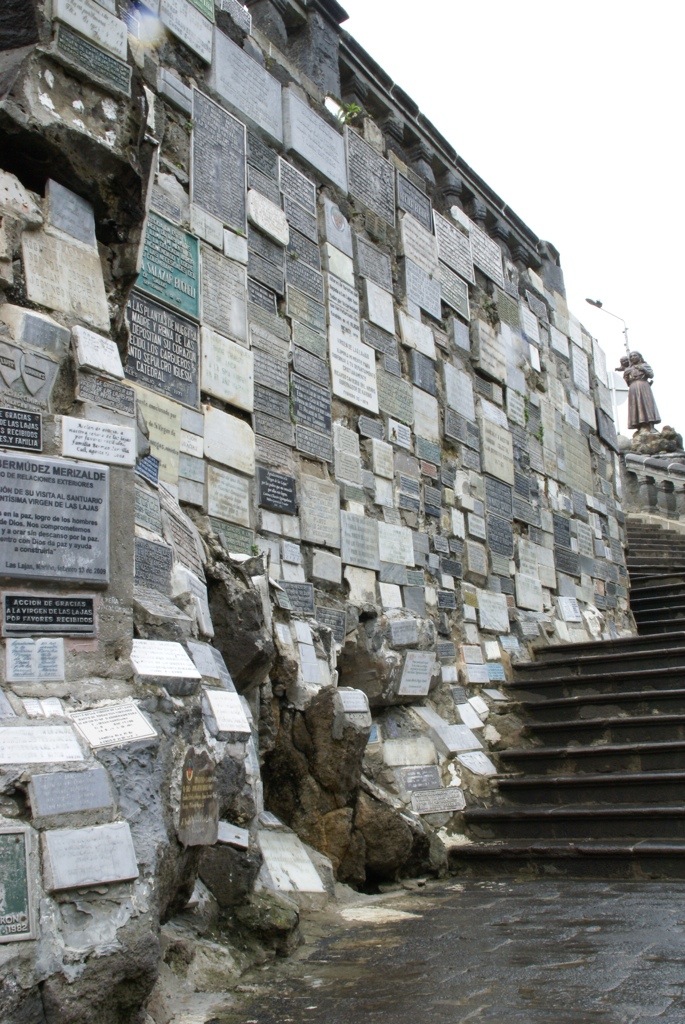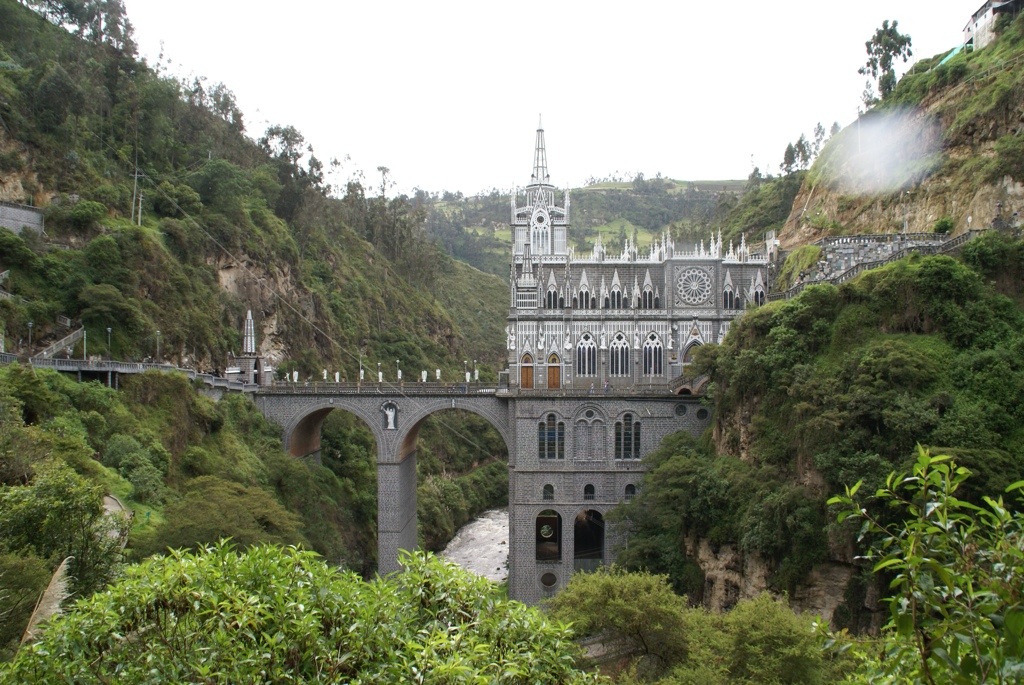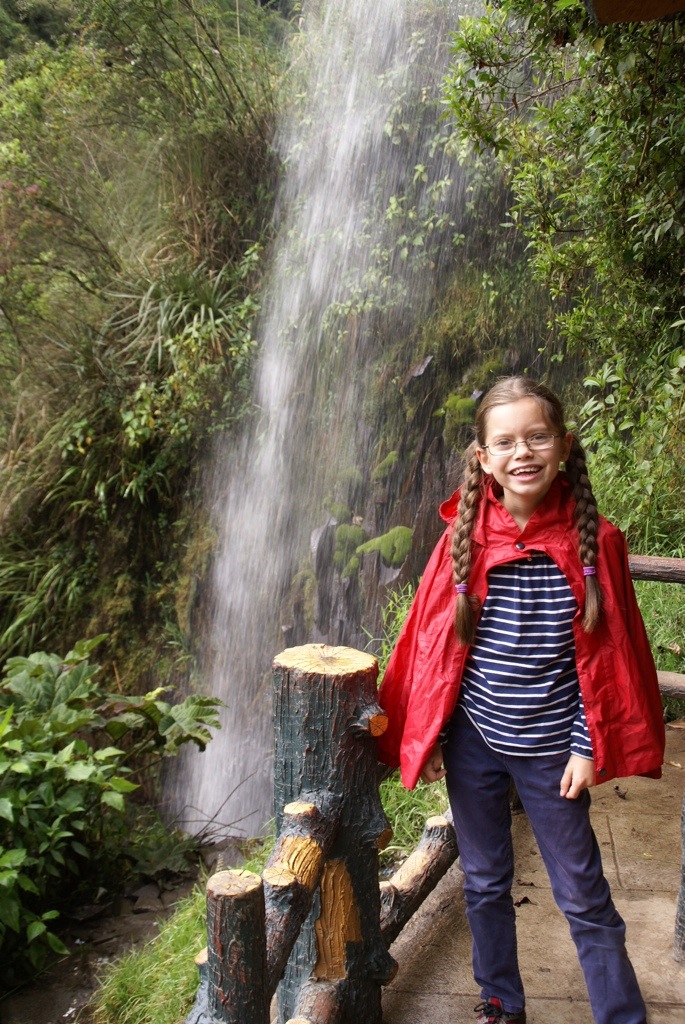My younger brothers keep on sending me messages asking "How is the holiday is going?" while I love hearing from them, it is the word "holiday" that bothers me. I know it is just a matter of semantics and me getting on my high-horse and to many people what we are doing is a "holiday", especially if you are stuck at work and it is raining outside in Europe. But "holiday" to me brings to mind sun, sand and cocktails and to be true we certainly took advantage of the former two in Central America. However it does not bring to mind what we've been doing over the last few days.
It all started harmlessly enough. After breaking part of the monster drive across Colombia's central mountain range (again) we headed south early from Ibague and our over night stop. We did get pulled over by a cop. We had done anything wrong but he still wanted to see all our documents. He may have been looking for a bribe but Steve talked his way nicely out of that one. Actually he didn't talk his way out as he suddenly didn't speak any Spanish at all. Eventually the cop got bored with us not understanding his requests for booze or cigarettes. We were heading to Desierto de la Tatacoa, a place full of unusual eroded sandstone gullies and cliffs. As it is the wet season the surrounding countryside was far greener than usual but the area of sandstone pinnacles were still impressively orange and red hued. Our camping stop for the night made the most of the fabulous views.


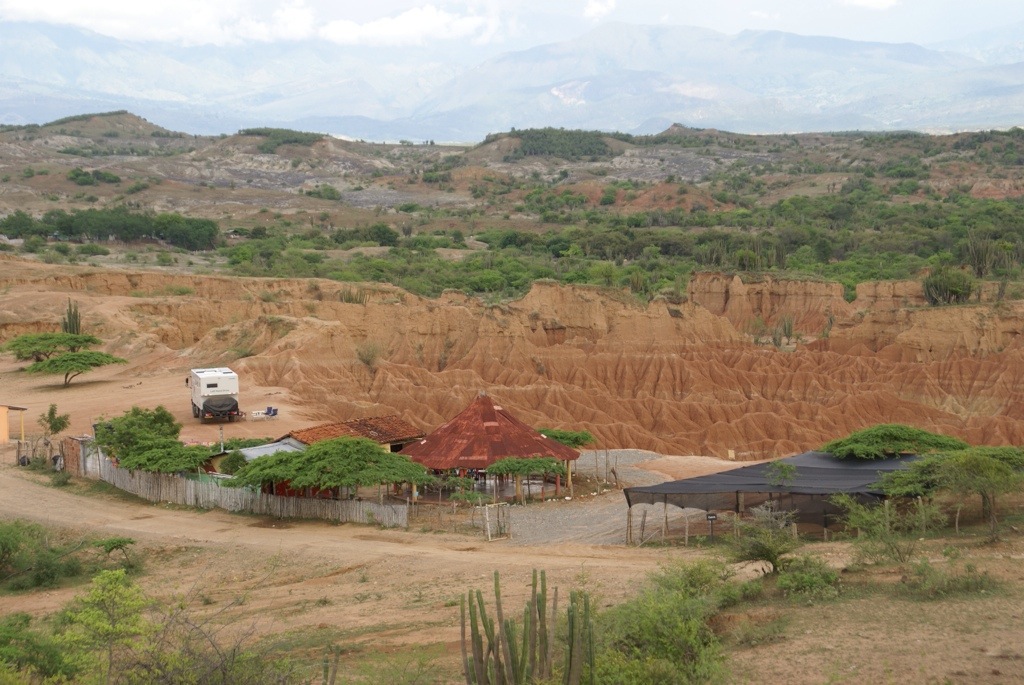
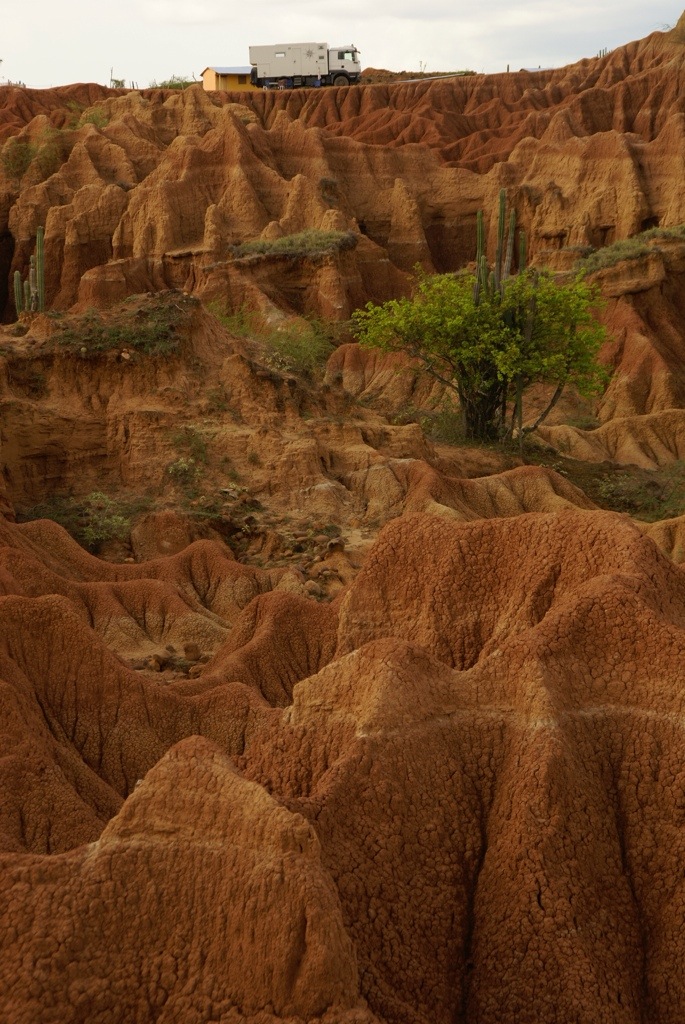

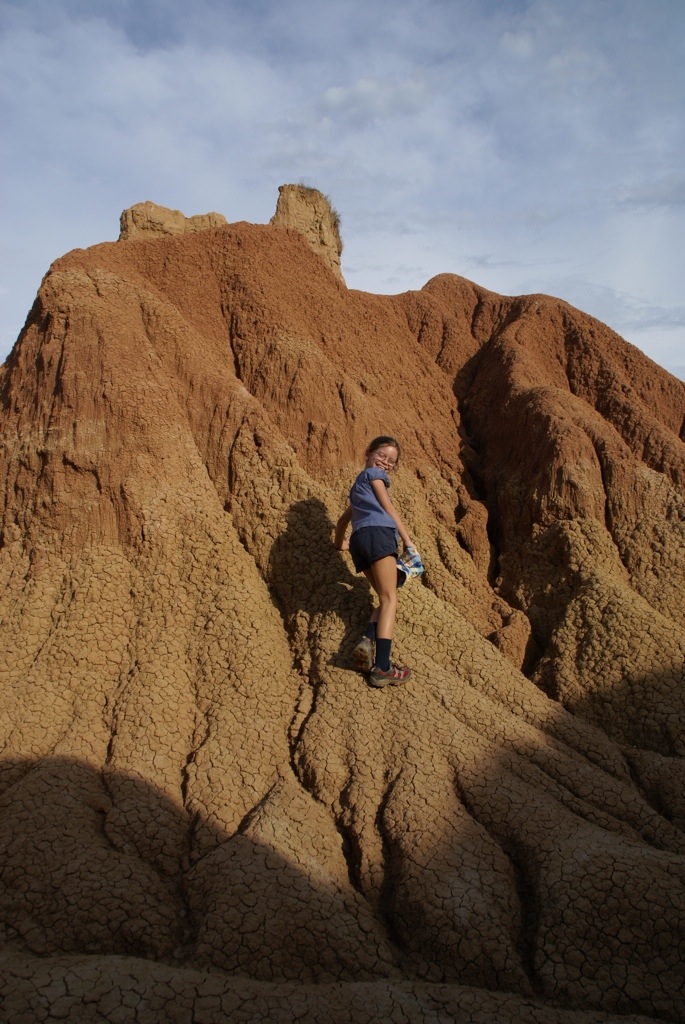
Desierto de la Tatacoa is also highly rated because of its clear skies and lack of light pollution. As we know nothing about star gazing we were keen to go to the observatory there and get a chance to look at the night sky. Unfortunately both girls had major breakdowns and were marched back to bed before 8pm. In any event it was pretty cloudy so there was not much to see.
We could hear the rumble of thunder from above distant mountains, as we sat outside looking at the moon hoping our wayward offspring were going straight to sleep for a change. Having read that the place is so dry because the surrounding mountains catch most of the rain, we weren't worried. As we settled in for the night the first storm drew in. The barrage of thunder claps sounded like a cannonade as lightening lit up the desert sky. Then the rain started to fall, you can use all the synonyms you want, it was all happening: a deluge, a down pour, raining cats and dogs, coming down in buckets... (us Brits have a lot of words for rain). We just lay there warm and snug being thankful that at last the girls had gone to sleep and were sleeping through the racket and that the repairs to our roof hatches we made a couple of weeks ago appeared to be holding up. With the noise still going we fell asleep, only to we awakened at one and three to new thunderstorms rolling in and every hour or so after that to listen to the rain changing its intensity between heavy and absolutely pissing it down. Oh and there was a couple of hours before dawn where we both lay there trying to mentally calculate how thick and sticky the mud was going to be.
When we'd parked up the previous day the parched ground was cracked and dry.

At 6.30 we bundled the girls through the hatch between the cab and the back before they were fully awake. As the truck started its 5 point turn to get out of the campsite the back end started to slide down the small incline towards a small ditch, it was only due to Steve's quick manoeuvring that it didn't go any further. We breathed a sigh of relief when we got to a gravel patch only to find out that it doesn't matter how much gravel you put down after 10cm of rain, a ten and a half ton truck will still sink though.
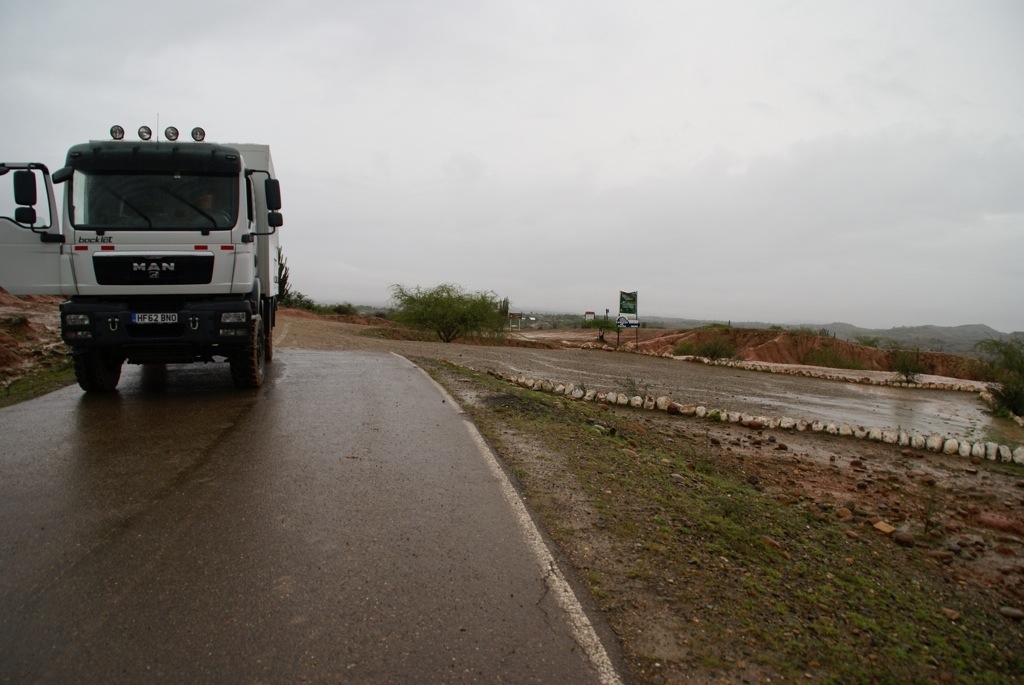
I took this photo. When we were firmly back on the road.
The drive out overlooking the valley below on the (thankfully!) tar road showed how flooded the surrounding area had become.
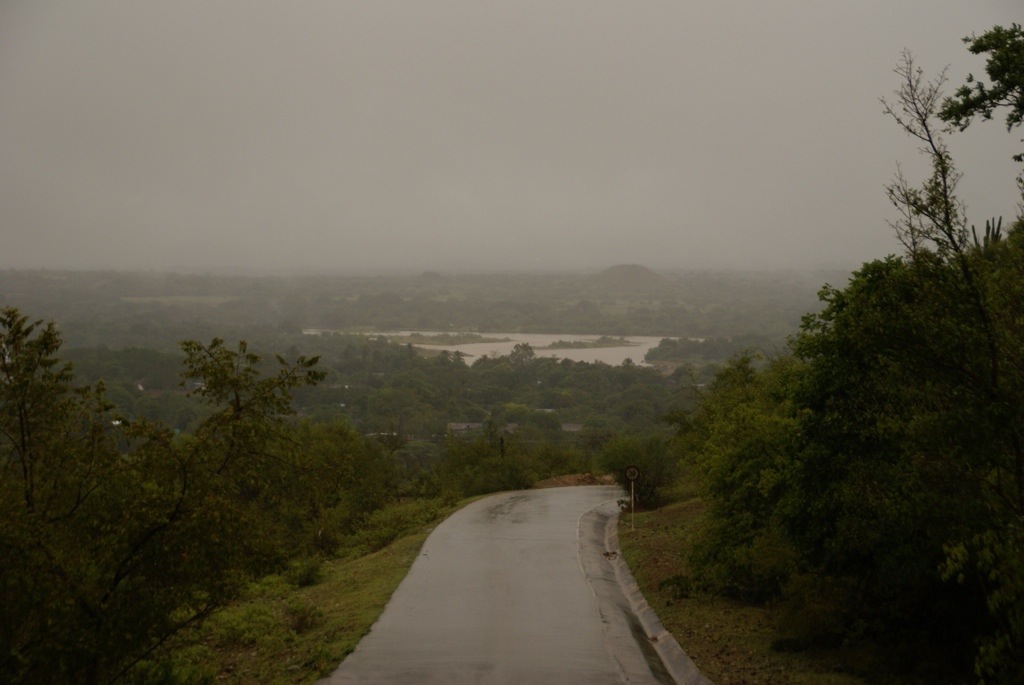
A stop in the next town of Nieve was needed for fuel, food, water, school and so we could wash the copious mud off our boots at the fuel station feeling like a couple of country hicks.
After that we were back on the road south, next stop San Augustin. An archeological sight famed for its pre-Columbian statues. We've been keeping an eye on the farmer's strike situation since we got caught up in it near Villa de Leyva. The problems were far less wide spread than last year, with really just two pockets of trouble. Where we'd been near Villa de Leyva and down near San Augustin. We'd hoped that as the "Campesinos" (farmers) were still in negotiations till Tuesday and it had dropped off of the national news altogether that everything would go smoothly. We passed a carriageway filled with abandoned tractors as we passed through one town, there were no campesinos and the police were in their usual uniforms, not riot gear unlike last week, and were slouched around glued to their phones. So we felt confident.
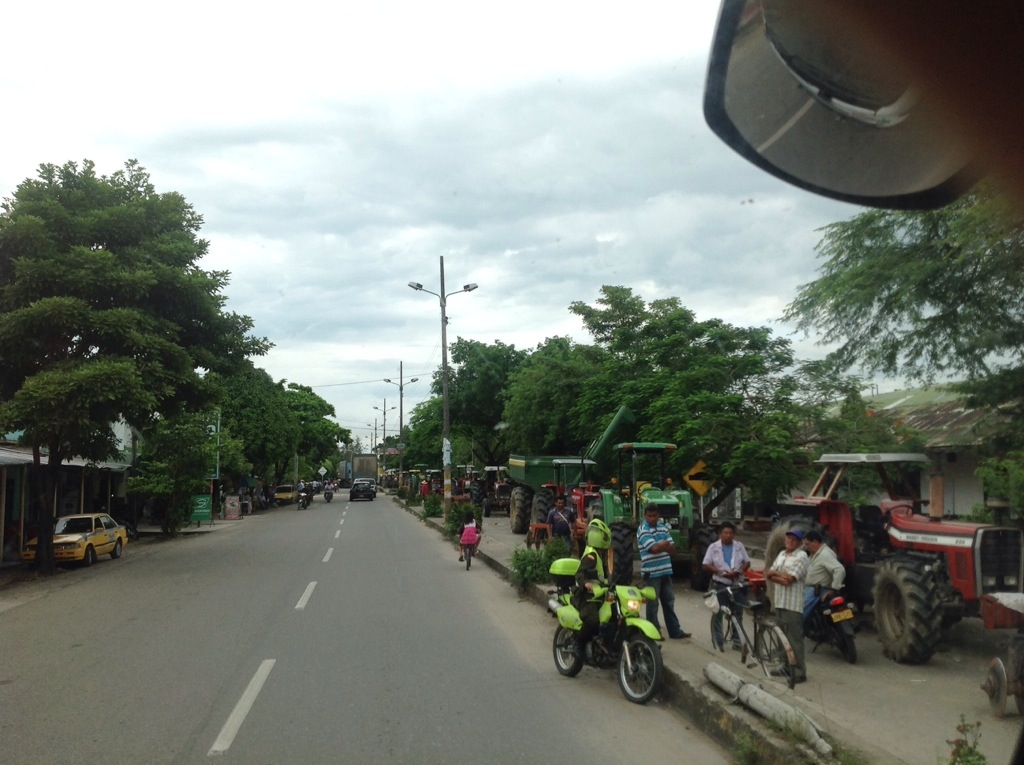
We passed a couple of campesino camps on the way down. They had blocked half the carriageway but the police kept the other half of the road open for traffic. There was a heavy police presence but neither side looked antagonistic. The protestors had their banners out and the police were in their normal gear. Although we did see they had their full riot gear stored just down the road. Just 45 minutes from our proposed destination and after a 5 hour drive we saw a group of people and vehicles in the road ahead. Pulling up, we found the road blocked by fencing and branches. There was a group of about 20 farmers and absolutely no police or military. The bare chested leader swaggered up to the cab. We politely explained who we were and where we were going. Initially we thought they would let us pass but then the other farmers objected. They said they were undergoing negotiations and that we should wait but that there was a bigger protest further ahead and the they were "much more dangerous guys". Mmmm..... we refused their kind offer of a spot on the side of the road as politely as we could. Steve did a stately reverse down the narrow road to a gate way and then executed a very speedy 3 point turn. Heading back into the town we'd just driven through 40 minutes before we stopped at the ubiquitous police open road block. We asked them if they knew the road was blocked "yes," came the slightly bored reply. At times like this that our Spanish fails us, what we'd like to have said was... "WTF!!! Why didn't you flag us down and stop us going that way? We waved at you, you could have easily made some sort of signal that we should stop. It is obvious we are foreign tourists going to one of Colombia's biggest sights and we can't get through because there is a whole group of pissed off farmers blocking the way."
We looked at our options obviously San Augustin was out. Our next destination Popayan, was back over the mountainous spine that runs down the centre of Colombia. There isn't a great number of roads that criss cross it as it is hard work putting a road in, in those conditions. We'd hated the road we'd driven just two days before across the mountains further north. It had been full of trucks slowly grinding their way through tortuous curves and it appeared that a significant number of them had suicidal tendencies. So a 600 km detour back including another go on that road wasn't a very attractive option. Popayan was back on the Panamerican highway and on the way to our proposed exit to Ecuador, so we had to get there somehow. Looking at the map there was a large town La Plata which had a small road leading up to it from where we were. From La Plata according to the map there were two possible routes to Popayan. It was now 4.30 and we were keen to get out of the area. Learning from our previous mistake we pulled over at the police stop on the road to La Plata and quizzed the officer. Yes it was the road to Popayan via La Plata, yes it was open and yes it was suitable for trucks of our size. We even got an approximate time frame, we should easily make it before dark. Hooray! this was the road for us, Steve gunned the engine. The road started beautifully winding tar through scenic hills scattered with black and white dairy cows and no signs of aggrieved farmers. We passed through a couple of villages and managed to negotiate the illogical pathway through them. If it looks like the road out of town is absolutely opposite the road into town on the map, I can almost absolutely guarantee that you shouldn't take the road linking them directly. All these little towns have a known way through them for larger vehicles, however as everyone knows it they don't bother putting up any signs. It is only stupid outsiders, like ourselves who come a cropper. We now repeatedly ask, almost at every corner as we wiggle through the tiny streets.
Then the road got narrower....Ok we can do this.
Then the tar ran out...no problem.
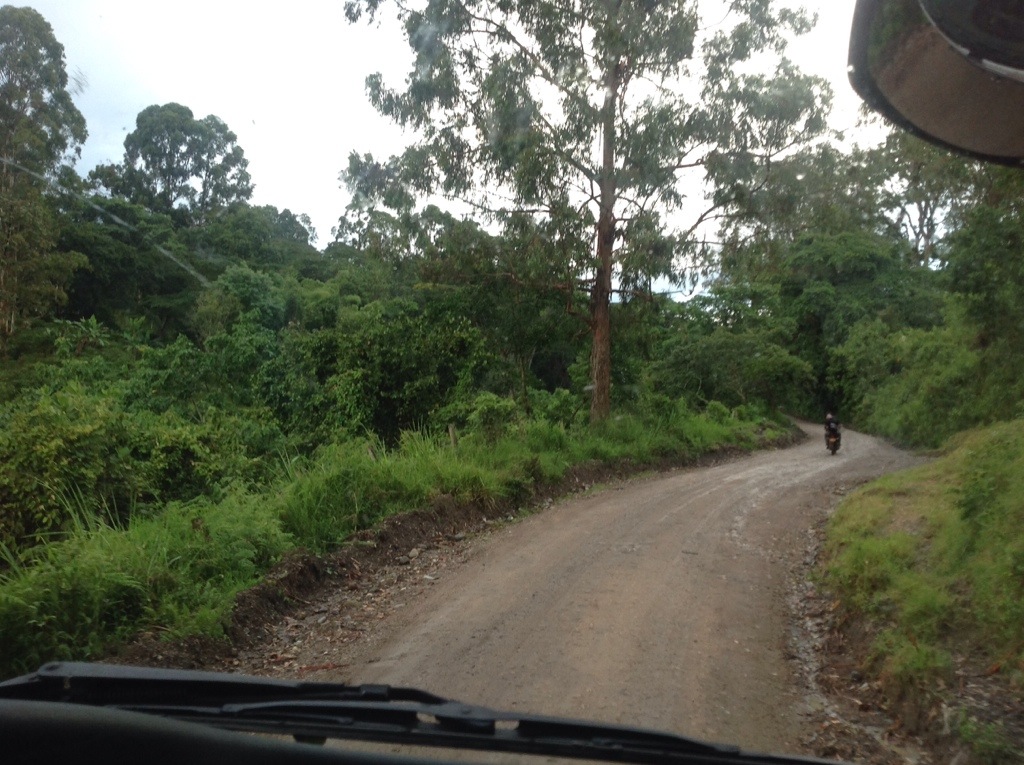
Big trucks and jeeps passing.... easy-peasy.

Heavy rain...bring it on.
Cows...naturally, but the tar had returned for a tantalising kilometre.

Just 3km short of La Plata, we came across this....actually at this point we could have started crying but actually we both just cracked up laughing. Trust our luck!
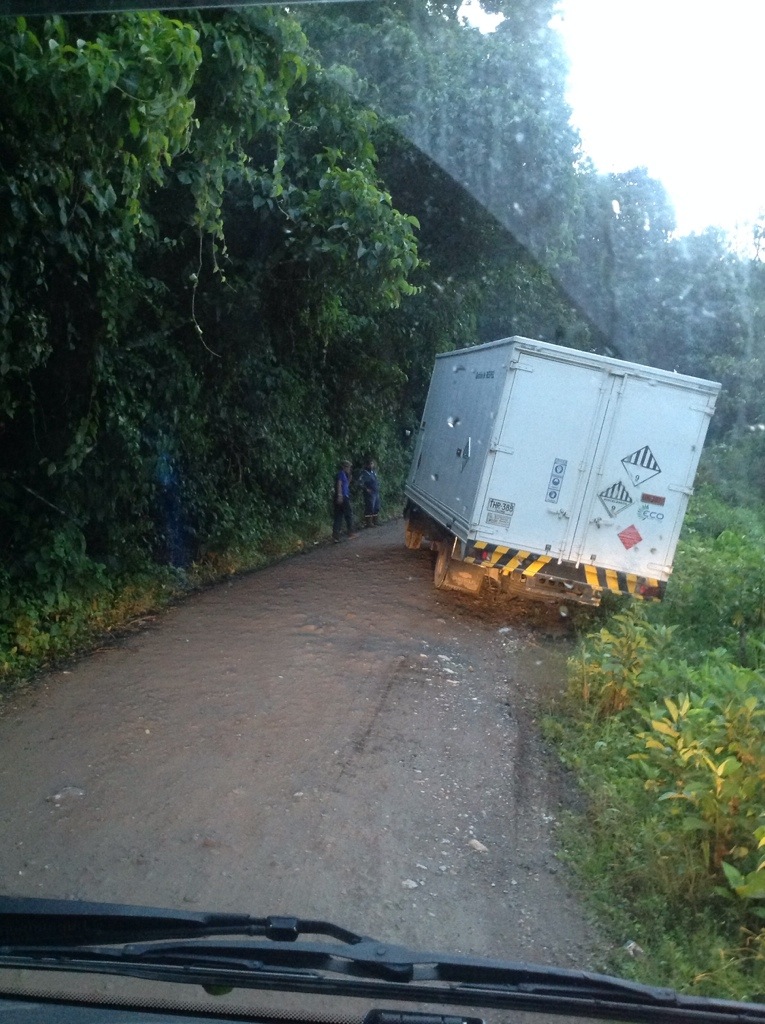
In the end it didn't end up being a big a pain as we thought. We couldn't pull it out backwards but they'd sent for a tow truck which turned up just as it got dark. The biggest problem after that was trying to avoid the motorbike with no lights being driven by a man and with three large children on the back, oh yes, and one of the children was carrying a huge tray of eggs, as he tried to overtake us off-road.
We actually slept quite well in the quiet of a lorry park on the outskirts of La Plata that night.

Back on the road the following morning we took the route to Popayan that was signposted and vowed we'd ask at the police stop on the way out of town about the road conditions. The first sign that something was amiss was perhaps the lack of a police stop at the edge of town. There are police or military everywhere on the roads in Colombia. With their recent history you can see why. Every few kilometres you'll see a sign, you slow down and they give you a thumbs up to continue on, nothing to it. But there was nothing here and by then there were only motorbikes and the crazily stacked full jeeps on the road, so we forged ahead. The second sign was a few small rocks and a branch in the road, we proceeded carefully. The third sign was a large group of people and objects in the road about 400m off. Steve executed his second speedy u-turn in the same number of days and we found ourselves back in La Plata.
In the absence of any police we asked at the petrol station about the other road, we were reassured with many jaunty "Si, Señors" when we asked about the direction, state, openness and size of the road ahead. We even double quizzed him, to check he wasn't just answering yes to everything. I made Steve stop several more times to check with other road users about the route, all was looking good. So we were off again. The road out was perfect; a two way concrete carriage way, obviously the sign was lying and this was the best way to Popayan. Sure enough though within a few kilometres it became apparent that this beautiful new highway, was a work in progress. The concrete stopped often at the worst bits while they built a bridge or whatever before it started again. Soon after that the concrete stopped altogether and we were just left with a muddy single lane road with even muddier sections of roadworks, where they were hacking away the mountainside. At one of these points we were soon held up for 40 minutes or so. We were soon centre of attention for the bored lorry drivers and a group of electricians who were waiting as well. Just to be on the safe side, I checked with the assembled throng about the route. There was a concerned murmur through the group, the road was fine but we should be very careful as there were dangerous armed groups in the hills around Belalcazar. Great! Just great! Just the words all parents want to hear as they transport their much loved offspring half way around the world. I have to admit I went into my very quiet, not very rational, internal panic response. We then quizzed them extensively about the routes from La Plata back to where we came from the preceding day. It turns out that negotiations with the campesinos had broken down and all the other roads out of town were blocked too. The town hadn't felt at all threatened, everyone had been going about their normal morning business, so we felt could return to town to stay but would run the risk of being stuck there until the farmers were happy with their deal from the government and that could be weeks or we could continue on. More drivers joined the group and they had slightly different opinions. They thought the road we were going to take would be fine but we should in no circumstances drive it at night and we shouldn't miss the all important turn west. Much discussion went on in the cab. As the roadworks cleared, we decided that we should continue on. The drivers stopped at the junction west just a few kilometres on and made sure we didn't miss our turning.
The road was quiet with small holdings every few kilometres and stunning alpine scenery. We slowly counted down the kilometre markings from above 100.
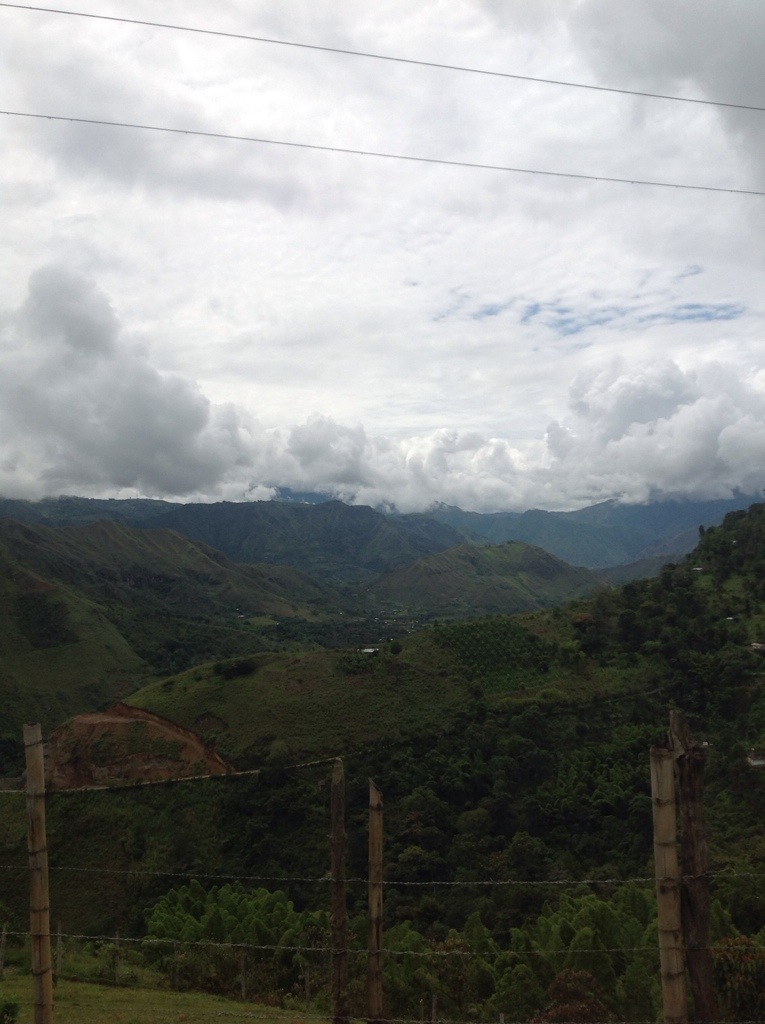
We passed directly through the town on Inzes as they were having their Saturday market. In the central square we had to squeeze past a hugely overloaded chiva, a local bus made of wood on a truck base stuffed to the gills with people and goods with about 10 people and their belongings as overflow on the roof. It would have made a fantastic picture but it didn't seem a good place or time to whip out a camera. I did manage to find an empty one with its rain covers on later to photo.
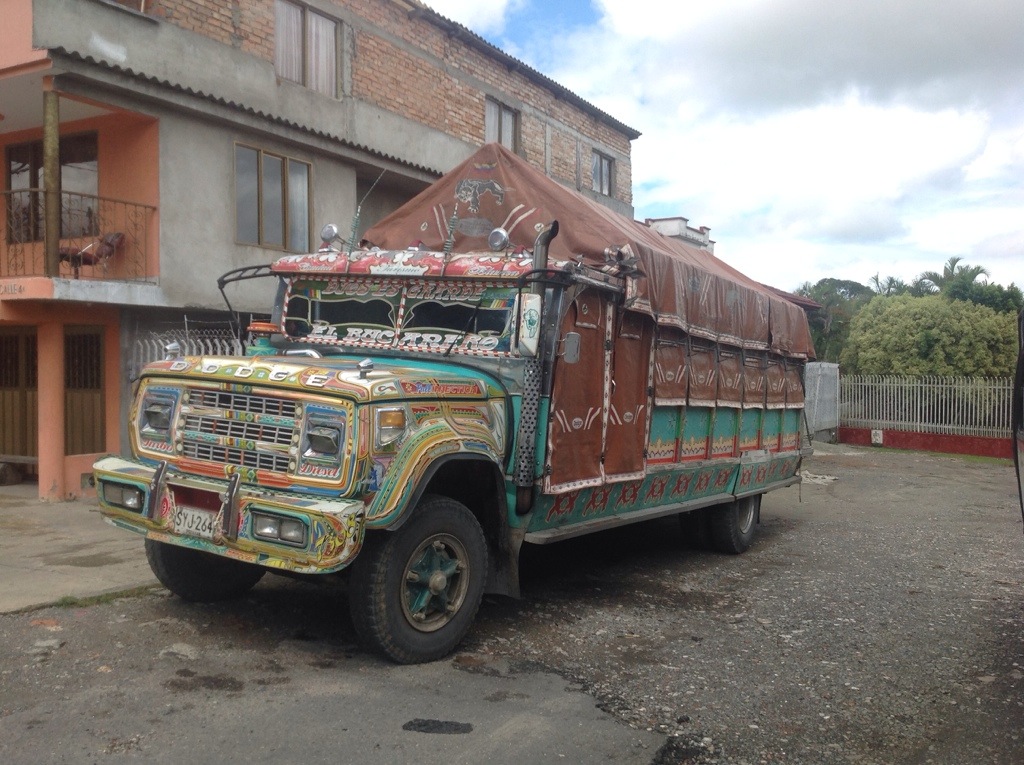
The roadworks returned, a good sign in my book as they weren't going to send a new road into bandit territory. Hardwork for Steve though, as the mud was thick and slick and the rock slides were aplenty.
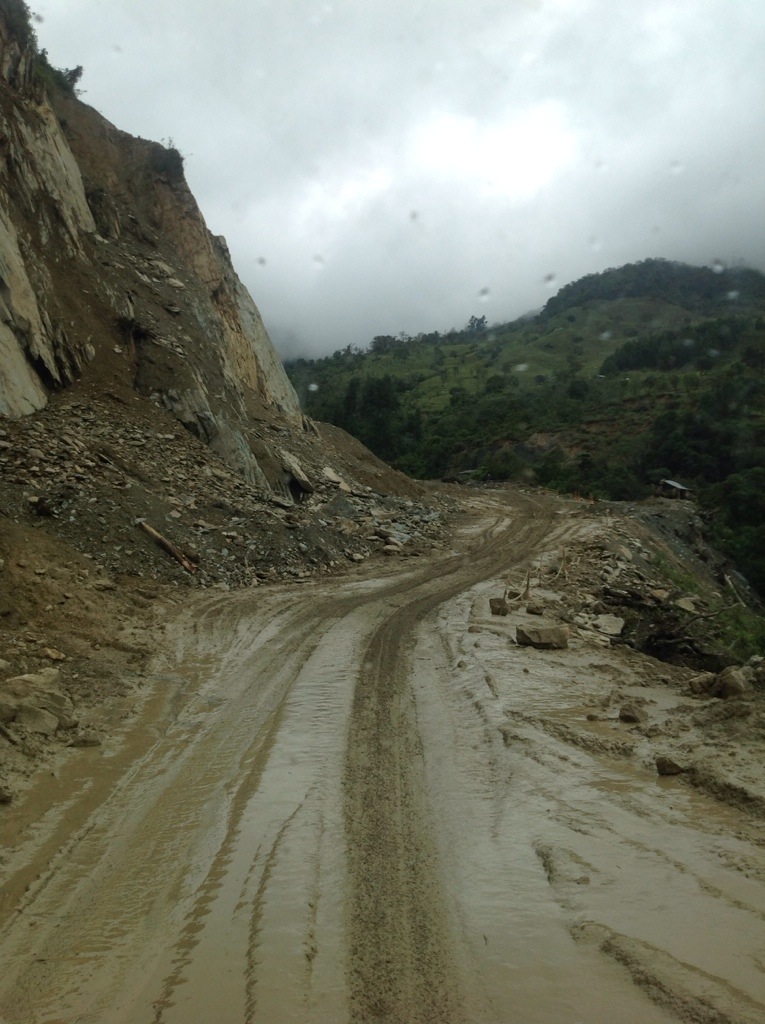
We entered the clouds for a while at one point at the top of a pass.
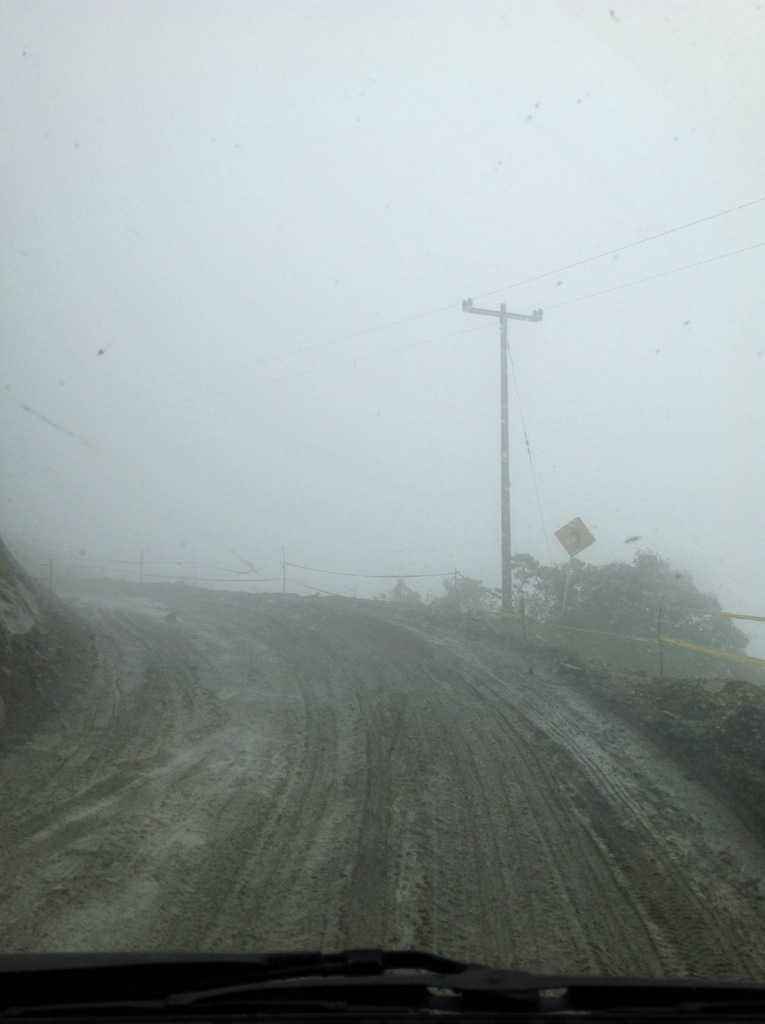
There were plenty of other nasty bits and other road hazards for Steve to contend with.

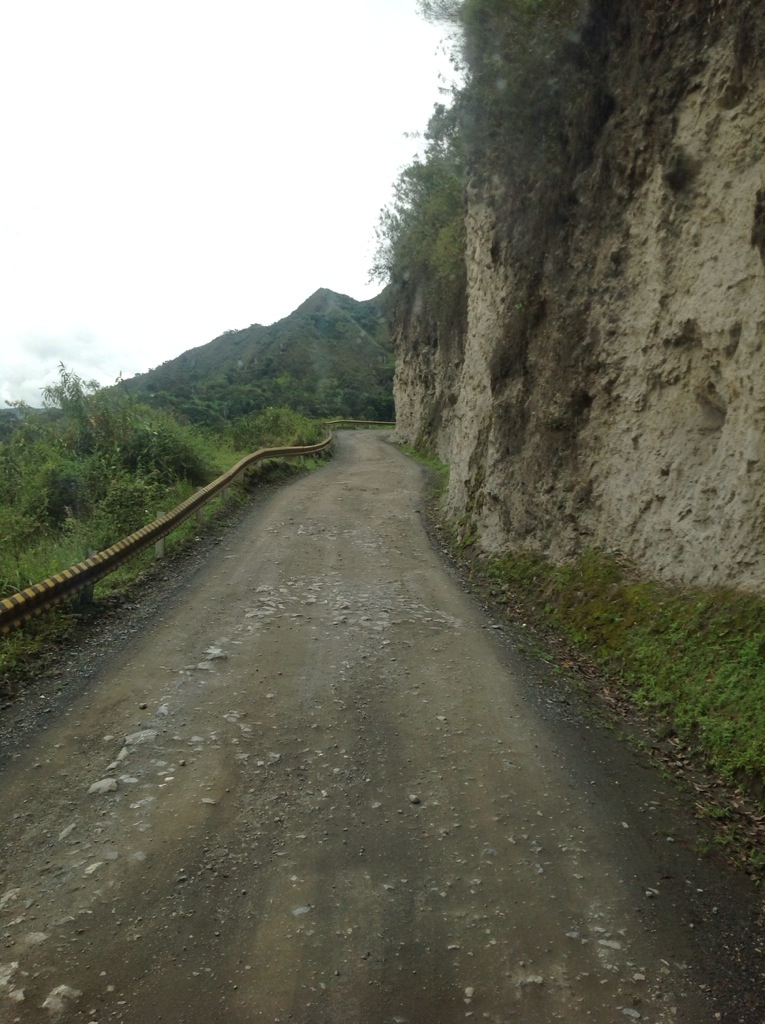

We came across the paramo, high altitude plains that are typical of this region.
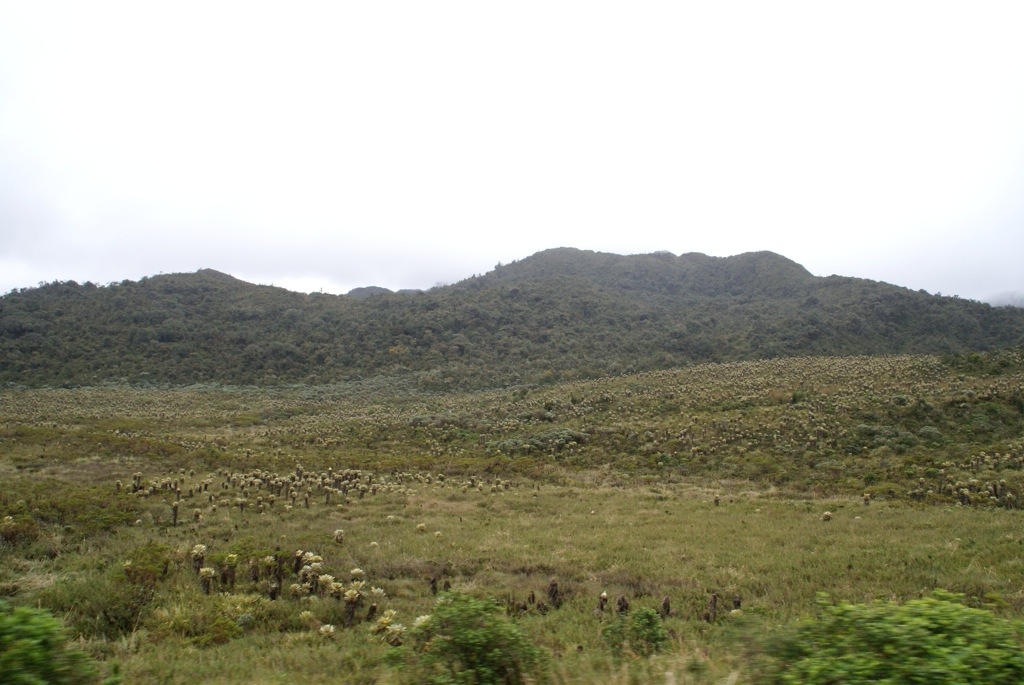
And eventually after 7 exhausting hours on the road wound our way down the mountains into Popayan. Safe, without incident and just happy to sleep in a car park for a few nights.
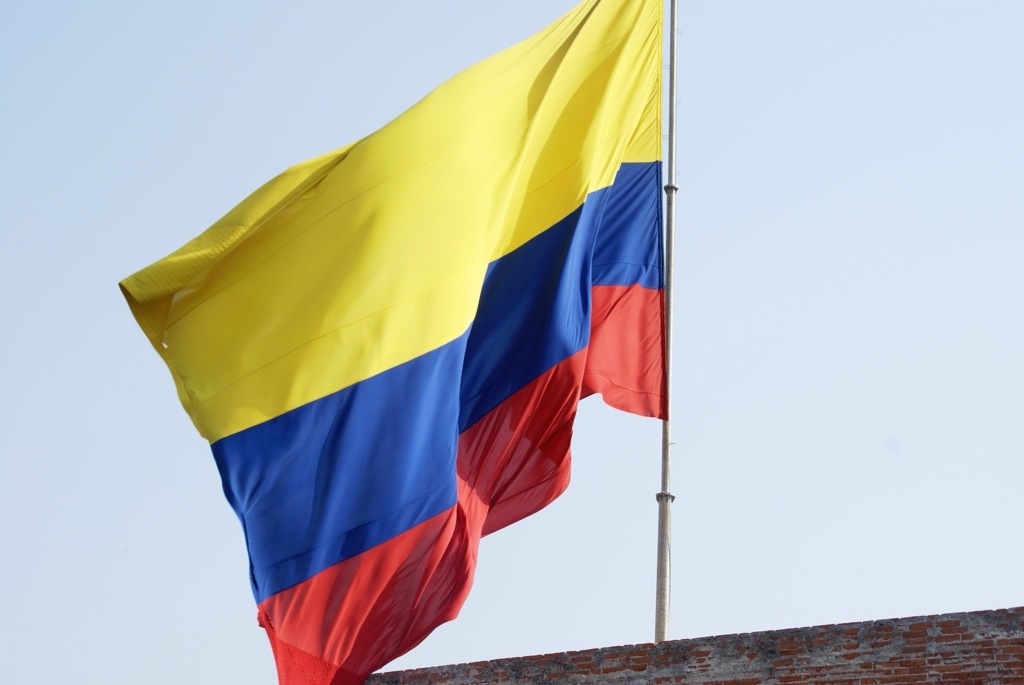 Lucy
I saw a big dinosaur fossil and trees, sap and fish which had been turned into fossils.
We also met a dog named Goldie, we don't know if it was his real name but that is what I called him.
I also ate a big bottomed ant. It was crunchy and tasted a bit weird. It was a famous dish in that part of Colombia. Here is a drawing of me eating it.
Lucy
I saw a big dinosaur fossil and trees, sap and fish which had been turned into fossils.
We also met a dog named Goldie, we don't know if it was his real name but that is what I called him.
I also ate a big bottomed ant. It was crunchy and tasted a bit weird. It was a famous dish in that part of Colombia. Here is a drawing of me eating it.
 Alisha
In Cartagena we learnt all about pirates and me and Lucy played pirates at the castle. Here is a quick drawing of Cartagena.
Alisha
In Cartagena we learnt all about pirates and me and Lucy played pirates at the castle. Here is a quick drawing of Cartagena.
 Even though it has rained a lot in Colombia I have enjoyed been in the mountains because it is cooler and I have been able to wrap myself up in my duvet at night to get all snug.
I really enjoyed the dance show in Barichara. I took a video of it so I could watch it again and again but unfortunately my camera memory ran out half way through.
Gilly
We've found Colombia a great introduction to South America. The diversity of the scenery has given us plenty to see and experience.
The stand out places for me have been up in the Andes. Even with the cloud coverage in El Cucoy National Park, the views were stupendous. At the end of Central America I was saying to Steve what I was most looking forward to in South America were the epic drives, the journey to El Cucoy definitely fulfilled this. We have crisscrossed the central mountain range three times and although the drives have occasionally gave me palpitations, the vistas have been breathtaking.
Even though it has rained a lot in Colombia I have enjoyed been in the mountains because it is cooler and I have been able to wrap myself up in my duvet at night to get all snug.
I really enjoyed the dance show in Barichara. I took a video of it so I could watch it again and again but unfortunately my camera memory ran out half way through.
Gilly
We've found Colombia a great introduction to South America. The diversity of the scenery has given us plenty to see and experience.
The stand out places for me have been up in the Andes. Even with the cloud coverage in El Cucoy National Park, the views were stupendous. At the end of Central America I was saying to Steve what I was most looking forward to in South America were the epic drives, the journey to El Cucoy definitely fulfilled this. We have crisscrossed the central mountain range three times and although the drives have occasionally gave me palpitations, the vistas have been breathtaking.
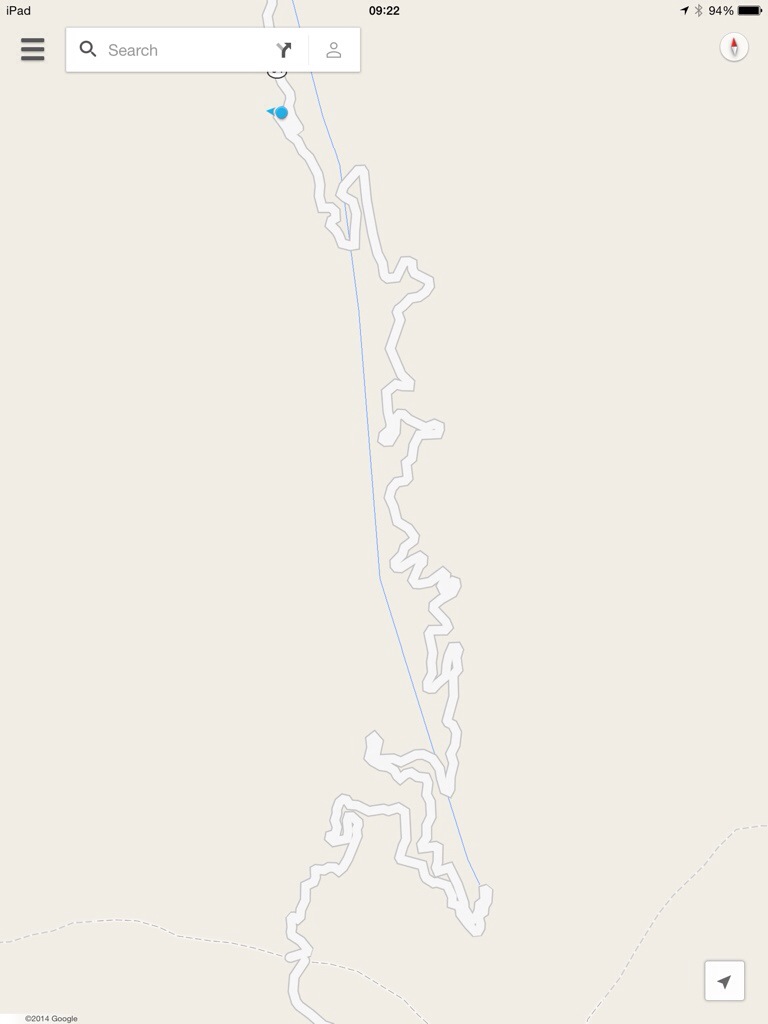 With the relatively recent improvements in security and economic growth the government is having a major upgrade of the road networks. Hopefully this will bring more economic opportunities to remote communities and help with continued improvements in security. Unfortunately for us it has meant lots of slow roads with roadworks. Obviously the other downside to our time in Colombia has been the farmer's strike. Although our plans weren't too drastically affected it did cause us a lot of stress and concern.
The main memory I will take away from here though is the lovely people. It's not just the amazing scenery that gets many travellers raving about this place, it's the welcome they get from the population.
Steve
Colombia is a country in transition. It is emerging from its troubled past and is developing rapidly. There are large investments going into infrastructure as we could see from all the road works and there is a large and growing middle class that means the country has all the facilities you need. There is though still a large poorer part particularly in the countryside.
It is a fascinating time to visit Colombia and as tourism is still quite new the sights are not full of tourists. The scenery in the country is spectacular and there is a huge variety of different landscapes from Caribbean beaches, to high mountain tops, to beautiful coffee highlands to deserts. There are also some wonderful colonial towns that have been very well preserved. We spent 5 weeks in Colombia and could easily have spent more.
Colombia's biggest asset though is its people. They were the most friendly and welcoming people we have met on the trip so far. Everywhere we went people were helpful, friendly and genuinely interested in what we were doing. They were also very keen to know how we were liking Colombia and wanted to ensure we were enjoying it as much as possible. I hope as tourism increases they manage to retain this friendliness.
The countries in South America are much bigger than those we have recently visited in Central America and it means a lot of driving to reach the sights. It has not been easy getting around and traveling has been much harder. Whilst the main roads are generally good tar there are still lots of roadworks and the roads are full of heavy trucks. As the roads often wind there way over large mountains this can make driving very slow. There are few places to pass so you can end up been stuck behind trucks for a long time. When you get off the main roads the roads often become gravel or mud which can be a challenge in the wet season. Again there are many roadworks so these roads are been improved too. All of this combined with the issues of the farmers strike which involved some roadblocks has meant travelling has been much more of a challenge. But it has been well worth it.
With the relatively recent improvements in security and economic growth the government is having a major upgrade of the road networks. Hopefully this will bring more economic opportunities to remote communities and help with continued improvements in security. Unfortunately for us it has meant lots of slow roads with roadworks. Obviously the other downside to our time in Colombia has been the farmer's strike. Although our plans weren't too drastically affected it did cause us a lot of stress and concern.
The main memory I will take away from here though is the lovely people. It's not just the amazing scenery that gets many travellers raving about this place, it's the welcome they get from the population.
Steve
Colombia is a country in transition. It is emerging from its troubled past and is developing rapidly. There are large investments going into infrastructure as we could see from all the road works and there is a large and growing middle class that means the country has all the facilities you need. There is though still a large poorer part particularly in the countryside.
It is a fascinating time to visit Colombia and as tourism is still quite new the sights are not full of tourists. The scenery in the country is spectacular and there is a huge variety of different landscapes from Caribbean beaches, to high mountain tops, to beautiful coffee highlands to deserts. There are also some wonderful colonial towns that have been very well preserved. We spent 5 weeks in Colombia and could easily have spent more.
Colombia's biggest asset though is its people. They were the most friendly and welcoming people we have met on the trip so far. Everywhere we went people were helpful, friendly and genuinely interested in what we were doing. They were also very keen to know how we were liking Colombia and wanted to ensure we were enjoying it as much as possible. I hope as tourism increases they manage to retain this friendliness.
The countries in South America are much bigger than those we have recently visited in Central America and it means a lot of driving to reach the sights. It has not been easy getting around and traveling has been much harder. Whilst the main roads are generally good tar there are still lots of roadworks and the roads are full of heavy trucks. As the roads often wind there way over large mountains this can make driving very slow. There are few places to pass so you can end up been stuck behind trucks for a long time. When you get off the main roads the roads often become gravel or mud which can be a challenge in the wet season. Again there are many roadworks so these roads are been improved too. All of this combined with the issues of the farmers strike which involved some roadblocks has meant travelling has been much more of a challenge. But it has been well worth it.
